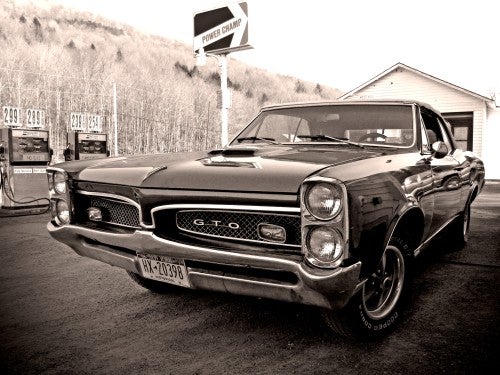Have you ever noticed how much our perception of somebody changes after their death? All the sudden, our memories of that person get rosier. The same can be said of the automotive nameplates who have been put out to pasture. Today starts a new series here on Auto News and Commentary: Dearly Departed.
It's hard to believe, but it's been more than a year and a half since the last Pontiacs rolled off the assembly line. The red-arrowhead brand, promoted as GM's "performance" division, came to be associated to oddly ribbed body cladding and Tupperware interiors. This wasn't always the case, though, as there was a time when Pontiac actually lived up to its performance image.
Founded in 1926 as an earnest, quiet, and stylish car, it wasn't until the 1950's that the brand's performance aspirations began to be realized. Under the direction of Bunkie Knudsen and John Delorean, the division was steered towards power, performance, and style. The GTO package on the Tempest LeMans proved to be so popular that is became its own model for the 1966 model year. Later, the launch of the Firebird Trans Am (itself a version of Chevrolet's Camaro) furthered the brands performance image.
Throughout the 1960's, Pontiacs grew in both size and power. While this decade-long run of performance vehicles created some of the most sought-after classics today, the oil crisis and tightening emissions standards of the 1970's were the beginning of the long end for Pontiac.
GM's corporate "downsizing" of models was in full swing by the mid-'70s, and the first front wheel drive Pontiac (the Phoenix) hit the scene for the 1980 model year. From there on out, Pontiacs mostly became sportier bodies on front wheel drive GM platforms, save for the Camaro-based Firebird. The Trans Sport minivan, a badge-engineered GM "dustbuster", debuted in 1990.
By the mid-1990's, Poncho's march towards irrelevancy was well under way. After the 1988 discontinuing of the radical Fiero coupe, Pontiac no longer had an exclusive model in their lineup. Each vehicle could be found in one form or another on Chevrolet, Oldsmobile, or Buick dealer's lots.
The dawn of the new millennium promised big changes for the brand: The Aztek made the show circuit as a concept car in 1999, and was available at Pontiac dealers for the 2001 model year. "Questionable" styling kept the Aztek from catching on, and the ribbed designs Pontiacs had been wearing since the launch of the 1999 Grand Am were growing old.
Pontiacs last grasp at life spawned the lineup it would die with. The G6 sedan replaced the Grand Am for 2004, followed by the 2006 Solstice convertible, the 2006 Torrent CUV, 2006 G3 subcompact, 2007 G5 compact, and 2008 G8 sports sedan.
While the Solstice and G8 were engaging, exciting cars that lived up to their performance pedigree, the G5 (a Chevy Cobalt clone) and G3 (a Chevy Aveo clone) were quite the opposite of "Driving Excitement."
The division found itself a casualty of GM's bankruptcy, but it was probably best that way. You never want see a good man suffer in death, and a car fan never wants to see a once prestigious nameplate relegated to badge-engineered mediocrity. Now that Pontiac is gone, I tend to think less about the G6 and Aztek, and more about the GTO (the real GTO) and G8.
Farewell, Poncho, we'll remember your best days, and try to forget your worst.






Well done Ross. I have fond memories of Pontiac's heyday of the 1960s. The classy Grand Prix, Muscular GTO and Luxurious Bonneville. Sadly, Pontiac lost its way and identity after John Z. DeLorean left to helm Chevy and GM's homoginization of badge jobs in the '70s and '80s killed every reason for the Tin Indian to exist.
ReplyDeleteRe: "Tin Indian"
ReplyDeleteThanks for reminding me of that one! I haven't heard it in a long time.